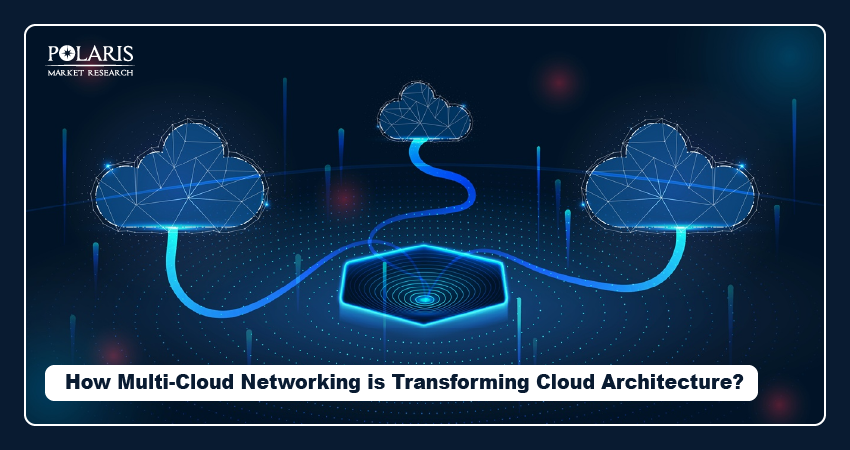How Multi-Cloud Networking is Transforming Cloud Architecture?

The past decade has seen an increasing number of businesses shifting to cloud platforms. This high cloud adoption has resulted in organizations seeking multi-cloud architectures. However, the shift towards multi-cloud architectures brings with it the challenge of managing connectivity and performance across these disparate environments. This is where multi-cloud networking comes in.
Multi-cloud networking offers a unified solution for managing and optimizing networking across multiple cloud platforms. This blog post covers the fundamentals of multi-cloud networking and its various layers. It also details the current state of the multi-cloud networking market and sheds light on the key factors fueling its growth trajectory. Furthermore, it covers how advanced technologies like artificial intelligence (AI) are transforming the multi-cloud networking landscape. Continue reading!
What is Multi-Cloud Networking?
Multi-cloud networking is an IT strategy used by businesses to diversify the usage of their cloud. As the name implies, it involves using services from two or more cloud computing platforms rather than relying on a single cloud provider. This helps achieve a multi-faceted approach to the digital requirements of businesses. This method helps avoid the pitfalls associated with relying on a single vendor. Additionally, multi-cloud networking allows businesses to leverage the distinct advantages provided by each cloud platform.
What Are the Layers of Multi-Cloud Network Architecture?
As explained earlier, a multi-cloud network architecture harnesses the benefits offered by different cloud service providers. The architecture consists of four different operational layers. Below, we’ve explained them in detail:
Cloud Core
The cloud core layer serves as the foundation of a multi-cloud network architecture. It encompasses the services provided by different cloud providers. These services can take the form of storage, compute, and database services. It typically includes shared services that allow for seamless communication and operation of applications deployed across multiple cloud providers. In essence, the layer abstracts away the need to deal with the complexities of individual cloud platforms.
There are two sub-layers within the cloud core layer. These include the application layer and the global transit layer. The application layer encompasses the key applications and services needed for the operations of the organization. The global transit layer offers connectivity and allows for traffic to flow between distinct cloud regions.
Security Layer
The security layer is a key component for protecting data and applications across several cloud environments. It involves the implementation of consistent security policies and data encryption across all cloud platforms. The security mechanisms in this layer can take the form of encryption and decryption services, web application firewalls, and security policies. Additionally, it includes compliance management tools that allow businesses to meet the regulatory needs concerning data privacy and security.
Access Layer
The access layer is important for connecting users and devices. These users and devices may take the form of customers, partners, employees, branch offices, and data centers. The access layer ensures that resources are only accessible to authorized entities. Additionally, it enables the implementation of security measures like authentication, authorization, and encryption. The connection between the end users and the network is facilitated by devices such as routers, switches, and wireless access points. Some access layers may also include components that allow for traffic routing and load balancing between multiple cloud providers.
Operations
The operations layer is responsible for the ongoing management and maintenance of the various cloud services and resources across different cloud providers. This layer encompasses various tools, processes, and technologies, such as integrated cloud management platforms. IT teams use the tools and technologies of the operations layer for managing and optimizing the performance and availability of the multi-cloud infrastructure. Monitoring and analytics tools are also a part of the operations layer. With analytics, enterprises can have real-time visibility into the availability and performance of the multi-cloud environment.
What Are the Key Market Highlights?
Our latest analysis reveals the multi-cloud networking market to register robust growth in the coming years. The market for multi-cloud networking is projected to register a CAGR of 22.5% between 2025 and 2034. The market is projected to reach USD 36.56 billion by 2034.
What Are the Benefits of Multi-Cloud Networking?
There are several benefits associated with multi-cloud networking. Below, we’ve explained them in detail:
Improved Flexibility: Multi-cloud allows businesses to choose from several cloud providers. That way, organizations have the flexibility of matching specific features and capabilities that optimize their workloads across the cloud.
Enhanced Reliability: With multi-cloud, businesses can distribute their workloads across various systems. This helps reduce the downtime associated with the outage of a single cloud provider.
Cost Efficiency: Multi-cloud environments provide a good option for reducing IT spending. The use of public cloud is associated with less overhead. Additionally, it enables businesses to scale up or down based on their specific requirements. The use of multi-cloud also reduces the risk of vendor lock-in.
What Is the Impact of AI on Multi-Cloud Networking?
AI is transforming how businesses manage and utilize multi-cloud environments. The use of AI automates routine tasks like provisioning and maintenance across cloud platforms. This helps reduce errors and frees up IT teams for strategic work. It also enables self-healing systems that can automatically detect and resolve issues.
AI algorithms have the capability to analyze network traffic and performance for the dynamic allocation of resources. These algorithms can also predict issues like bottlenecks or security vulnerabilities. Furthermore, AI-driven systems foster cloud security and offer real-time threat detection by monitoring for anomalies and enabling rapid response.
To Conclude
Multi-cloud networking provides organizations with the freedom to move their applications. That way, they can directly control their uptime, latency, and cost. Additionally, it offers constant access to network performance requirements. In the coming years, we can expect to see the key players in the multi-cloud networking market offering more advanced solutions to cater to the diverse needs of businesses globally.

